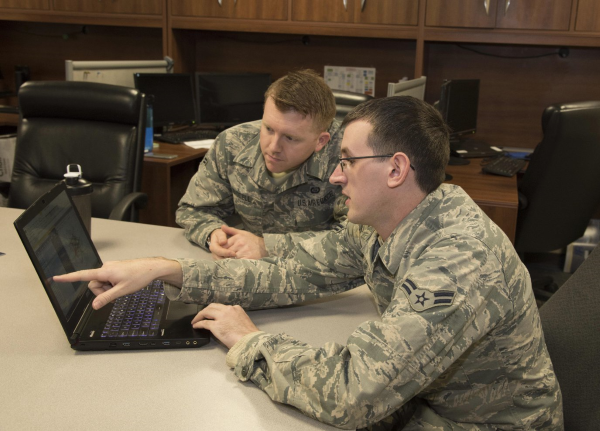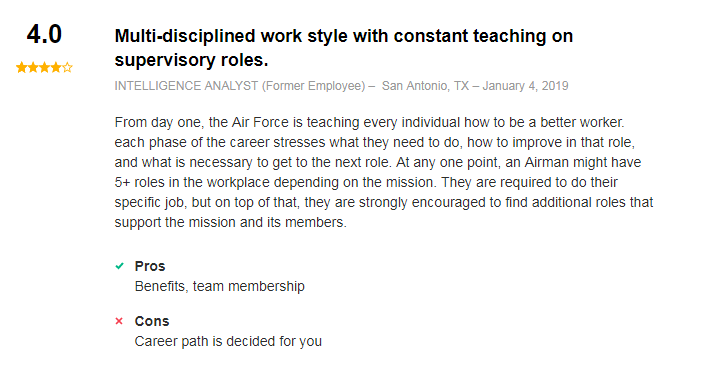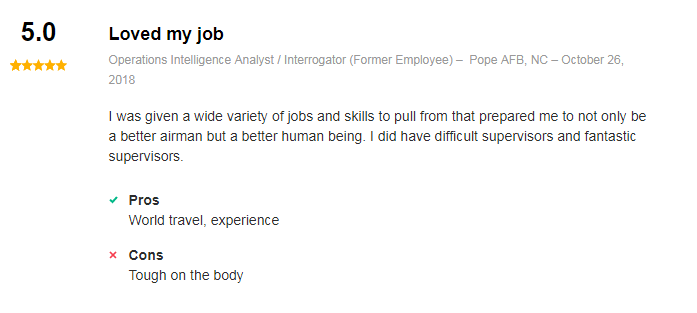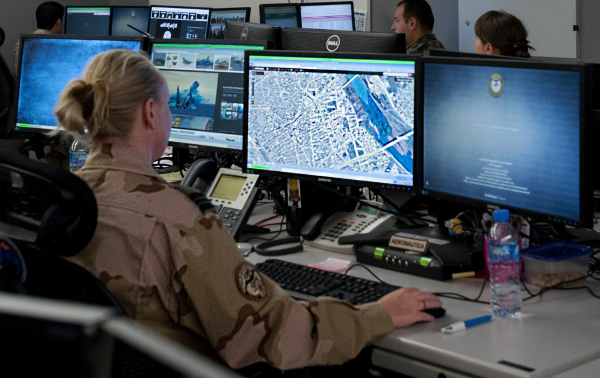Wars are not won just by having sophisticated equipment on the battlefield.
That’s because even if the United States has vastly superior equipment in the air, on the seas, and on the ground at its disposal, it will not do the commanders of those units any good if those assets are not properly positioned.
That’s where having good intelligence information comes into play and can be a huge difference-maker in any conflict zone.
Air Force Fusion Analysts are charged with gathering up all the intelligence information at their disposal, interpreting it, and then getting it to those commanders that can best put that intelligence information to good use.
Related Article – Cyberspace Operations Officer: Pay, Training, And More
That’s why Air Force Fusion Analysts perform such a critical role in both peace and wartime.
If they do their job right, it can be a game-changer in a conflict — and if they get it wrong, it can make objectives in a conflict zone much harder to achieve.
So Fusion Analysts fill not only a demanding role in the US Air Force Intelligence community; what they do impacts all branches of the military and the federal government decision making process as well.
That means this Air Force job comes with some pressure but can also be extremely rewarding at the same time.
Air Force Fusion Analyst Requirements and Qualifications

Here the prerequisite requirements that must be met in order to enter into technical training to become an Air Force Fusion Analyst.
ASVAB Requirements
- Minimum ASVAB Score of 62 in the general category or 57 on General and 60 on the Cyber Test section
Additional Qualifications
- Be between the ages of 17 and 39
- High school diploma or GED
- Must speak clearly without any noticeable deficiencies
- Successfully complete a polygraph test
- Having background knowledge of electronics is much desired but not required
- Having a high school curriculum that included computer application, high-level math, and high-level English courses is desired but not required
- Successful completion of 8.5 weeks of Air Force Basic Military Training held at Joint Base Lackland in San Antonio, TX (Not required of those with prior military experience or training)
- Completion of a current Single Scope Background Investigation (SSBI) that leads to a Top Secret level security clearance
Training and Career Path to Become an Air Force Fusion Analyst
Here is the training it takes to be able to perform the duties that are required of an Air Force Fusion Analyst.
Air Force Technical Training Information
The Air Force technical training to educate future Air Force Fusion Analysts takes place at the Air Education and Training Command facility located at Goodfellow Air Force Base near San Angelo, Texas.
At four months in duration, this is one of the longer Air Force Tech Schools for enlisted personnel.
During their time spent at this training facility, new recruits will learn such things as the different intelligence platforms that the US Air Force uses, the various ways to interpret that intelligence, and how to support intelligence-related briefings.
They will also learn how to put together and analyze intelligence data that has been collected and how to then pass the reports generated to those in the chain of command who need it.
On the Job Training
The tech school environment to become an Air Force Fusion Analyst is great for providing the basics but, unfortunately, it is not a highly secure facility that grants its students access to the latest intelligence-gathering techniques.
That makes on the job training critical to any Air Force recruit that enters into this specialized career field.
A recruit can expect to spend three to four months training on the job before filling an assigned role on an Air Force Fusion Analyst team.
How Much Are Air Force Fusion Analyst Paid?
No matter what an enlisted person’s job is in the Air Force, they will always be paid based on their rank and the number of years of service.
Related Article: Air Force Ranks And Pay
Those who are new to the military and acting as an Air Force Fusion Analyst will most likely start out as an Airman Basic (E-1).
Recruits who possess prior knowledge or schooling that will benefit them in their time in this Air Force job may initially start out as an Airman (E-2) or Airman First Class (E-3).
Here is the current pay-table for Air Force enlisted personnel:
Miscellaneous Pay, Allowances, and Incentives
Other forms of pay that Air Force members are entitled to at certain times include:
- Housing allowance for those that live off base (BAH)
- Subsistence allowance (Food – BAS)
- Temporary duty pay
- Hazardous duty pay
- Flight pay
Health care for Air Force personnel is always 100% paid for.
What’s Life Like as an Air Force Fusion Analyst?
This is a fast-paced job that requires most enlisted personnel that do it to wear several different hats in the intelligence community.
There are times when the hours can be long, and there is also the constant possibility that an enlisted member may be summoned to work on short notice at any time of the night or day.
There are some temporary duty assignments that Air Force Fusion Analysts are asked to take on, but those requests usually only happen occasionally.
Here are some of the direct responsibilities that fall under the title of US Air Force Fusion Analyst
- Gather and interpret technical, geographical, and operational intelligence information
- Analyze the intelligence material that is presented to them to help determine adversarial threats and intentions
- Provide geopolitical and operational intelligence to both national government reporting agencies and military command authorities
- Produce and present high-interest current intelligence briefings to all levels of command
- Identify and interpret real-time threat warning data
- Advise commanders on force protection and intelligence information
- Use global communications to support a vast array of Computer Network Operations
These two YouTube videos go into more detail as to what Air Force Fusion Analysts do:
Job Reviews
Here is what three former Air Force enlisted members had to say on the website Indeed.com about their time spent working as Fusion Analysts:



Air Force Fusion Analyst Civilian Career Opportunities
Although there is not an abundance of civilian jobs in the U.S. for former Air Force Fusion Analysts, there are some good opportunities if one takes the time to look.
Perhaps the best way for those former Air Force Fusion Analysts who enjoyed their work to gain fulfilling and good-paying civilian jobs is to go to work for the federal government.
There are several government agencies that like to hire ex-military intelligence community members to fill positions.
These include:
- Defense Intelligence Agency – Washington, D.C.
- National Imagery and Mapping Agency (NIMA) – Springfield, Virginia
- Department of Homeland Security – Washington, DC
They hire Ex-military members not only for their job skills but because of the fact they already have active Top secret security clearances.
Related Article: 9 Common Private Military Contractor Jobs (and 3 uncommon ones)
A big bonus that former Air Force Fusion Analysts get when going to work for the federal government is that their military time counts toward retirement and for the number of vacation days an employee is entitled to each year.
Here are some civilian companies that are known to hire Ex-Air Force Fusion Analysts partly because of the security clearance that they possess:
- Boeing Aerospace Company – Chicago, IL
- General Dynamics Corporation – Falls Church, VA
- Raytheon Company – Waltham, MA
- Rand McNally – Chicago, IL
Other civilian companies that need the experience that former Air Force Fusion Analysts have include:
- Celestar Corporation – Cuba, MO
- General Dynamics Information Technology – Tampa, FL
- BAE Systems – Fort Belvoir, VA
- LinQuest Corporation – Washington, DC
References:
- 5 Worst Jobs in the Air Force - June 20, 2024
- 4 Steps For Visiting An Air Force Recruiter Near You - June 19, 2024
- Air Force Safety Specialist (1S0X1) - June 19, 2024
General FAQ
What do Air Force fusion analysts do?
USAF fusion analysts gather, interpret, and disseminate intelligence data, including geographical and operational information, regarding potential threats. They produce and present intelligence briefings to government agencies and military command authorities.
What ASVAB score do you need for fusion analyst?
To become an Air Force Fusion Analyst, you’ll need a minimum score of 62 in the General category or 57 on General and 60 on the Cyber Test sections of the Armed Forces Vocational Aptitude Battery.
How long is tech school for fusion analyst?
Tech school to become an Air Force Fusion Analyst is one of the longest, lasting four months and held at Goodfellow AFB, TX.
How much does a fusion analyst make?
USAF Air Force Fusion Analysts are paid accord to rank and time in service, like other military personnel. There may be retention bonuses for this position, however.
What can an Air Force Fusion Analyst do in the civilian world?
After separation or retirement, many Air Force Fusion Analysts find work with major aerospace companies or other contractors. They also can find employment with government agencies like the Department of Homeland Security or the National Imagery and Mapping Agency.

